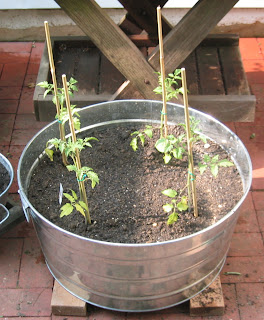 Mother-in-law and Father-in-law were in town this past week imparting their gardening wisdom on our lowly patio. This morning, as they were getting ready to leave, I looked out only to find that the Santa tomato plant had a severe injury. A fruit-laden branch had broken halfway through! How can I save this?
Mother-in-law and Father-in-law were in town this past week imparting their gardening wisdom on our lowly patio. This morning, as they were getting ready to leave, I looked out only to find that the Santa tomato plant had a severe injury. A fruit-laden branch had broken halfway through! How can I save this?I thought I might be able to tape it together so that it can heal. However, Husband and I tried this with a jalapeno pepper branch that held a flower bud. I think it was too late for the pepper because it had already started to wilt. The day after the tape bandage, it was clear that the operation was not a success. Mother-in-law said that we could try the tape bandage on the tomato, but that success hinged on the operation being performed very soon after the injury. To be honest, I have no idea when it happened. I don't remember anything unusual yesterday when I watered. However, I haven't been spending as much time in the garden for observation because it has been so Hazy, Hot, and Humid! Still I have hope that the injury was recent because the leaves haven't wilted yet.
 So that's what I did. I tried to make a supportive, binding, tape bandage. I don't know how it'll work. It occurred to me that I could try to make a clean cut and try to re-root the broken branch. If I see the leaves start to wilt, I will attempt the re-rooting procedure.
So that's what I did. I tried to make a supportive, binding, tape bandage. I don't know how it'll work. It occurred to me that I could try to make a clean cut and try to re-root the broken branch. If I see the leaves start to wilt, I will attempt the re-rooting procedure.How do you perform surgery on your broken tomatoes? Amputation or reattachment? Do you think my tape bandage will work? Is there a better way to bandage your plants? Should I try re-rooting the broken branch? If so, how should I do this? I'm frantic for answers, as the six or seven vulnerably attached tomatoes must be saved!


















